Balkans Mission Overview
Between 1992 and 2004, over 40,000 Canadian Armed Forces personnel served in the Balkans as part of international peacekeeping and stabilization efforts. Deployed to Bosnia, Croatia, Kosovo, and surrounding regions, their mission was to help restore order, protect civilians, and support the rebuilding of war-torn communities during a time of deep conflict and humanitarian crisis.
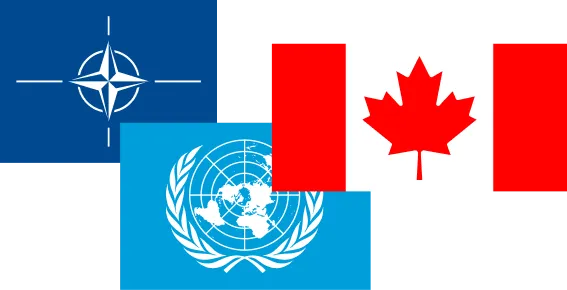

Yugoslavia 1918-1980
Yugoslavia (Land of the South Slavs') was a country in the Balkans that existed from 1918 to 1992. It came into existence following the First World War under the name of the Kingdom of Serbs, Croats and Slovenes. This followed the merger of the Kingdom of Serbia with the provisional State of Slovenes, Croats and Serbs, and constituted the first union of South Slavic peoples as a sovereign state. The merger came after centuries of foreign rule over the region under the Ottoman Empire and the Habsburg monarchy.
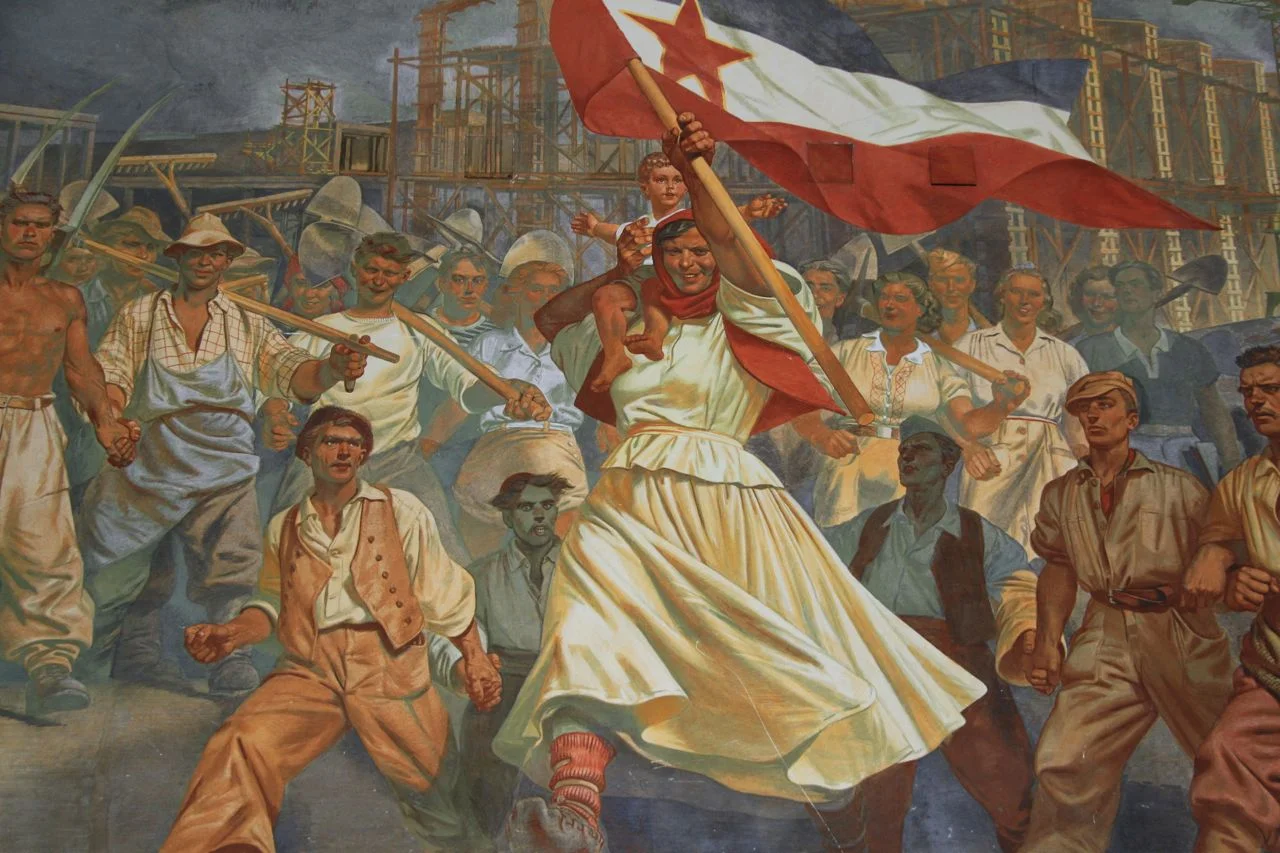
Mother Yugoslavia painting.
Under the rule of the House of Karađorđević, the kingdom gained international recognition on 13 July 1922 at the Conference of Ambassadors in Paris and was renamed the Kingdom of Yugoslavia on 3 October 1929. King Peter I was the country's first sovereign. Upon his father's death in 1921, King Alexander I went on to rule the country through an extended period of political crisis that culminated in the 6 January Dictatorship and, ultimately, his assassination in 1934. Prince Paul headed the state as a prince regent until Alexander's son Peter II was declared of-age, which happened following the Yugoslav coup d'état in March 1941. Alexander I was the longest reigning of the three Yugoslav monarchs.

German Panzer IV of the 11th Panzer Division advancing into Yugoslavia from Bulgaria as part of the 12th Army in April 1941. (Bundesarchiv_Bild_101I-770-0280-20)
The kingdom was invaded and occupied by the Axis powers in April 1941, marking the start of the Second World War in Yugoslavia. With the backing of the Allies the Communist-led Partisan resistance proclaimed the Democratic Federal Yugoslavia in November 1943. In 1944, King Peter II, then living in exile, recognized the Anti-Fascist Council for the National Liberation of Yugoslavia as the legitimate government. In November 1945, after the war ended, the regency council appointed by the King called a parliamentary election that established the Constituent Assembly of Yugoslavia. The Constituent Assembly proclaimed Yugoslavia a federal republic on 29 November 1945, thus abolishing monarchical rule. This marked the onset of a four-decade long uncontested communist party rule of the country. The newly proclaimed Federal People's Republic of Yugoslavia acquired the territories of Istria, Rijeka, and Zadar from Italy.

Partisan leader Josip Broz Tito ruled the country from 1944 until his death in 1980, first as the prime minister and later as the president. In 1963, the country was renamed for the final time, as the Socialist Federal Republic of Yugoslavia (SFRY).
The six constituent republics that made up the SFRY were the socialist republics of Bosnia and Herzegovina, Croatia, Macedonia, Montenegro, Serbia, and Slovenia. Within Serbia were two socialist autonomous provinces, Kosovo and Vojvodina. Following the adoption of the 1974 Yugoslav Constitution these provinces were largely equal to the other members of the federation.
Marshal Josip Broz Tito, named president for life on 7 April 1963. At the top of the Yugoslav government were the President (Tito), the federal Prime Minister, and the federal Parliament (a collective Presidency was formed after Tito's death in 1980).
1980-1992
After Tito's death on 4 May 1980, ethnic tensions grew in Yugoslavia. An economic and political crisis developed, leading to the rise of nationalism and ethnic conflicts. The system of decision-making was thrown into a state of paralysis, made all the more hopeless as the conflict of interests became irreconcilable. This led to the break up of Yugoslavia along its republics' borders during the Revolutions of 1989. The division into five separate countries, led to the Yugoslav Wars.
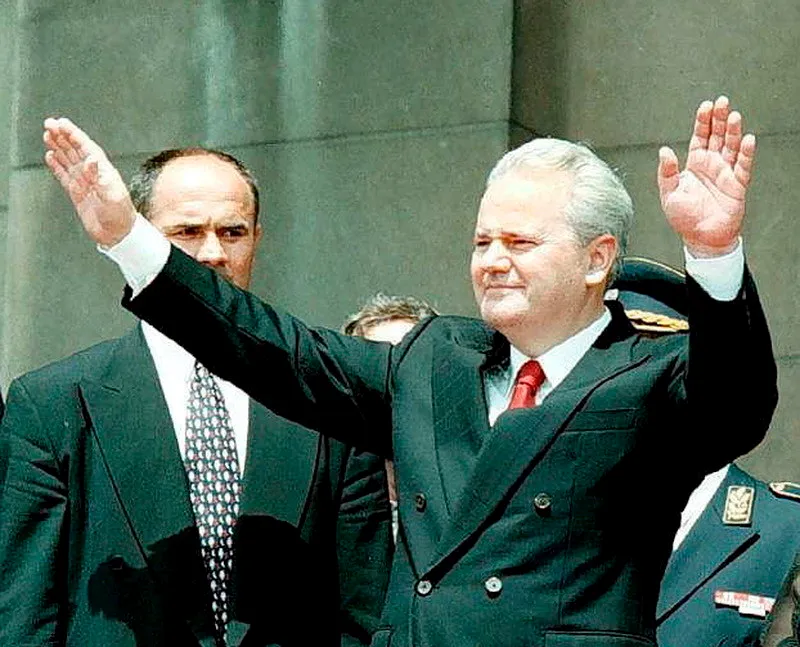
After Tito's death, Serbian communist leader Slobodan Milošević began making his way toward the pinnacle of Serbian leadership. In January 1990, the extraordinary 14th Congress of the League of Communists of Yugoslavia was convened, where the Serbian and Slovenian delegations argued over the future of the League of Communists and Yugoslavia. The Serbian delegation, led by Milošević, insisted on a policy of "one person, one vote" which would empower the plurality population, the Serbs. In turn, the Slovenian delegation, supported by Croats, sought to reform Yugoslavia by devolving even more power to republics, but were voted down. As a result, the Slovene and Croatian delegations left the Congress, and the all-Yugoslav Communist party was dissolved.
The constitutional crisis that inevitably followed resulted in a rise of nationalism in all republics: Slovenia and Croatia voiced demands for looser ties within the federation. Following the fall of communism in Eastern Europe, each of the republics held multi-party elections in 1990. Slovenia and Croatia held the elections in April since their communist parties chose to cede power peacefully. Other Yugoslav republics, especially Serbia, were more or less dissatisfied with the democratisation in two of the republics and proposed different sanctions (e.g. Serbian "customs tax" for Slovene products) against the two, but as the year progressed, other republics' communist parties saw the inevitability of the democratisation process.[citation needed] In December, as the last member of the federation, Serbia held parliamentary elections confirming the rule of former communists in the republic.
Slovenia and Croatia elected governments oriented towards greater autonomy of the republics (under Milan Kučan and Franjo Tuđman, respectively). Serbia and Montenegro elected candidates who favoured Yugoslav unity.[citation needed] The Croat quest for independence led to large Serb communities within Croatia rebelling and trying to secede from the Croat republic. Serbs in Croatia would not accept the status of a national minority in a sovereign Croatia since they would be demoted from the status of a constituent nation. (Wikipedia)
1990, The Yugoslav Wars
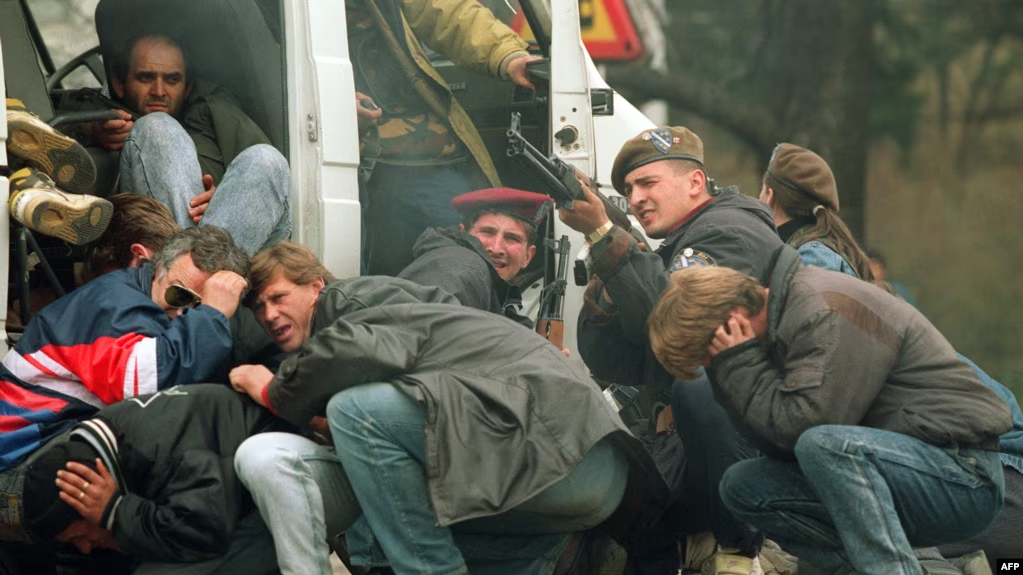
The war broke out when the new regimes tried to replace Yugoslav civilian and military forces with secessionist forces. When, in August 1990, Croatia attempted to replace police in the Serb-populated Croat Krajina by force, the population first looked for refuge in the Yugoslav Army barracks, while the army remained passive. The civilians then organised armed resistance. These armed conflicts between the Croatian armed forces ("police") and civilians mark the beginning of the Yugoslav war that inflamed the region. Similarly, the attempt to replace Yugoslav frontier police by Slovene police forces provoked regional armed conflicts which ended with a minimal number of victims.
A similar attempt in Bosnia and Herzegovina led to a war that lasted more than three years. The results of all these conflicts were the almost total emigration of the Serbs from all three regions, the massive displacement of the populations in Bosnia and Herzegovina, and the establishment of the three new independent states. The separation of Macedonia was peaceful, although the Yugoslav Army occupied the peak of the Straža mountain on Macedonian soil.
Serbian uprisings in Croatia began in August 1990 by blocking roads leading from the Dalmatian coast towards the interior almost a year before Croatian leadership made any move towards independence. These uprisings were more or less discreetly backed by the Serb-dominated federal army (JNA). The Serbs in Croatia proclaimed, "Serb autonomous areas", which were later united into the Republic of Serb Krajina. The federal army tried to disarm the territorial defence forces of Slovenia (the republics had their local defence forces similar to the Home Guard) in 1990 but was not completely successful. Still, Slovenia began to covertly import arms to replenish its armed forces.
Croatia also embarked upon the illegal importation of arms, (following the disarmament of the republics' armed forces by the federal army) mainly from Hungary. These activities were under constant surveillance and produced a video of a secret meeting between the Croatian Defence minister Martin Špegelj and two unidentified men. The video, filmed by the Yugoslav counter-intelligence (KOS, Kontra-obavještajna služba), showed Špegel announcing that they were at war with the army and giving instructions about arms smuggling as well as methods of dealing with the Yugoslav Army's officers stationed in Croatian cities. Serbia and JNA used this discovery of Croatian rearmament for propaganda purposes. Guns were also fired from army bases through Croatia. Elsewhere, tensions were running high. In the same month, the Army leaders met with the Presidency of Yugoslavia in an attempt to get them to declare a state of emergency which would allow for the army to take control of the country. The army was seen as an arm of the Serbian government by that time so the consequence feared by the other republics was to be total Serbian domination of the union. The representatives of Serbia, Montenegro, Kosovo, and Vojvodina voted for the decision, while all other republics, Croatia, Slovenia, Macedonia and Bosnia and Herzegovina, voted against. The tie delayed an escalation of conflicts, but not for long.
Following the first multi-party election results, in the autumn of 1990, the republics of Slovenia and Croatia proposed transforming Yugoslavia into a loose confederation of six republics. By this proposal, republics would have right to self-determination. However, Milošević rejected all such proposals, arguing that like Slovenes and Croats, the Serbs (having in mind Croatian Serbs) should also have a right to self-determination.
On 9 March 1991, demonstrations were held against Slobodan Milošević in Belgrade, but the police and the military were deployed in the streets to restore order, killing two people. In late March 1991, the Plitvice Lakes incident was one of the first sparks of open war in Croatia. The Yugoslav People's Army (JNA), whose superior officers were mainly of Serbian ethnicity, maintained an impression of being neutral, but as time went on, they became increasingly more involved in state politics.
On 25 June 1991, Slovenia and Croatia became the first republics to declare independence from Yugoslavia. The federal customs officers in Slovenia on the border crossings with Italy, Austria, and Hungary simply changed uniforms since most of them were local Slovenes. The following day (26 June), the Federal Executive Council specifically ordered the army to take control of the "internationally recognized borders", leading to the Ten-Day War. As Slovenia and Croatia fought towards independence, the Serbian and Croatian forces indulged in violent and perilous rivalry.
The Yugoslav People's Army forces, based in barracks in Slovenia and Croatia, attempted to carry out the task within the next 48 hours. However, because of misinformation given to the Yugoslav Army conscripts that the Federation was under attack by foreign forces and the fact that the majority of them did not wish to engage in a war on the ground where they served their conscription, the Slovene territorial defence forces retook most of the posts within days with minimal loss of life on both sides.
There was, however, evidence of a suspected war crime. The Austrian ORF TV network showed footage of three Yugoslav Army soldiers surrendering to the territorial defence force when gunfire was heard and the troops were seen falling down. None were killed in the incident, yet there were numerous cases of destruction of civilian property and civilian life by the Yugoslav People's Army, including houses and a church. A civilian airport, along with a hangar and aircraft inside the hangar, was bombarded; truck drivers on the road from Ljubljana to Zagreb and Austrian journalists at the Ljubljana Airport were killed.
A ceasefire was eventually agreed upon. According to the Brioni Agreement, recognised by representatives of all republics, the international community pressured Slovenia and Croatia to place a three-month moratorium on their independence. During these three months, the Yugoslav Army completed its pull-out from Slovenia, but in Croatia, a bloody war broke out in the autumn of 1991. Ethnic Serbs, who had created their own state Republic of Serbian Krajina in heavily Serb-populated regions resisted the police forces of the Republic of Croatia who were trying to bring that breakaway region back under Croatian jurisdiction. In some strategic places, the Yugoslav Army acted as a buffer zone; in most others it was protecting or aiding Serbs with resources and even manpower in their confrontation with the new Croatian army and their police force. In September 1991, the Republic of Macedonia also declared independence, becoming the only former republic to gain sovereignty without resistance from the Belgrade-based Yugoslav authorities. 500 US soldiers were then deployed under the UN banner to monitor Macedonia's northern borders with the Republic of Serbia. Macedonia's first president, Kiro Gligorov, maintained good relations with Belgrade and the other breakaway republics and there have to date been no problems between Macedonian and Serbian border police even though small pockets of Kosovo and the Preševo valley complete the northern reaches of the historical region known as Macedonia (Prohor Pčinjski part), which would otherwise create a border dispute if ever Macedonian nationalism should resurface (see Internal Macedonian Revolutionary Organization). This was despite the fact that the Yugoslav Army refused to abandon its military infrastructure on the top of the Straža Mountain up to the year 2000.
As a result of the conflict, the United Nations Security Council unanimously adopted UN Security Council Resolution 721 on 27 November 1991, which paved the way to the establishment of peacekeeping operations in Yugoslavia.
.webp)
In Bosnia and Herzegovina in November 1991, the Bosnian Serbs held a referendum which resulted in an overwhelming vote in favour of forming a Serbian republic within the borders of Bosnia and Herzegovina and staying in a common state with Serbia and Montenegro. On 9 January 1992, the self-proclaimed Bosnian Serb assembly proclaimed a separate "Republic of the Serb people of Bosnia and Herzegovina". The referendum and creation of SARs were proclaimed unconstitutional by the government of Bosnia and Herzegovina and declared illegal and invalid. In February–March 1992, the government held a national referendum on Bosnian independence from Yugoslavia. That referendum was in turn declared contrary to the BiH and the Federal constitution by the federal Constitutional Court in Belgrade and the newly established Bosnian Serb government.
The referendum was largely boycotted by the Bosnian Serbs. The Federal court in Belgrade did not decide on the matter of the referendum of the Bosnian Serbs. The turnout was somewhere between 64 and 67% and 98% of the voters voted for independence. It was not clear what the two-thirds majority requirement actually meant and whether it was satisfied. The republic's government declared its independence on 5 April, and the Serbs immediately declared the independence of Republika Srpska. The war in Bosnia followed shortly thereafter.
Canadian operations in the Balkans, 1991 to the present day
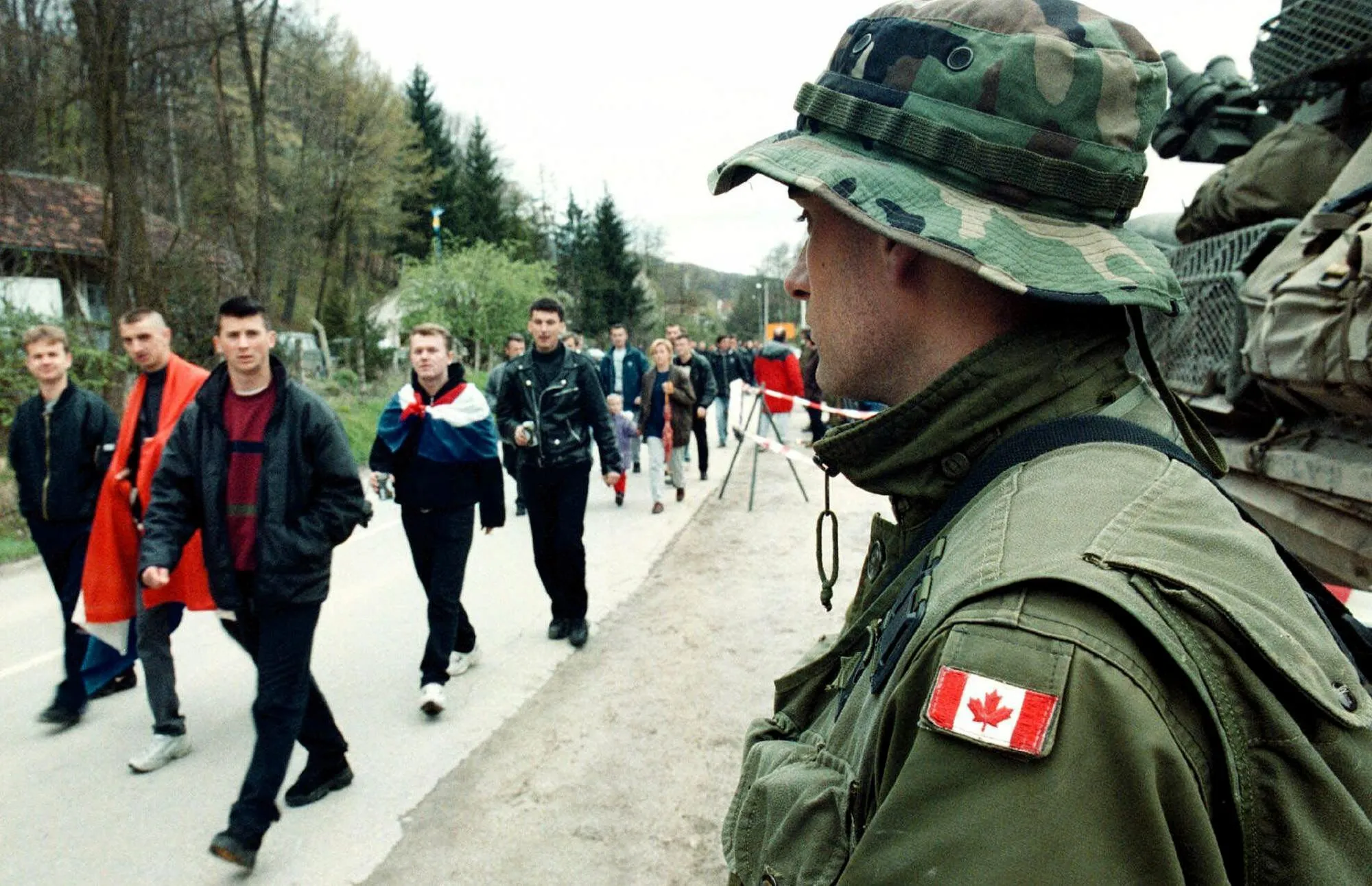
Canadians served in European Community, United Nations (UN) and North Atlantic Treaty Organization (NATO) missions in Croatia, Bosnia-Herzegovina, Serbia, Montenegro and Macedonia. These new countries arose from the ashes of the former country of Yugoslavia. As of 1991, tens of thousands of Canadian Armed Forces (CAF) members joined these missions in the Balkans region of southeast Europe. They worked to restore peace and security to the people there. The outbreak of fighting brought an international reaction. Slovenia and military forces in the rest of Yugoslavia fought a brief war in the summer of 1991. To help enforce a ceasefire, the European Community Monitoring Mission was set up. CAF officers joined this multinational peace support effort in September 1991.
The United Nations Protection Force (UNPROFOR)
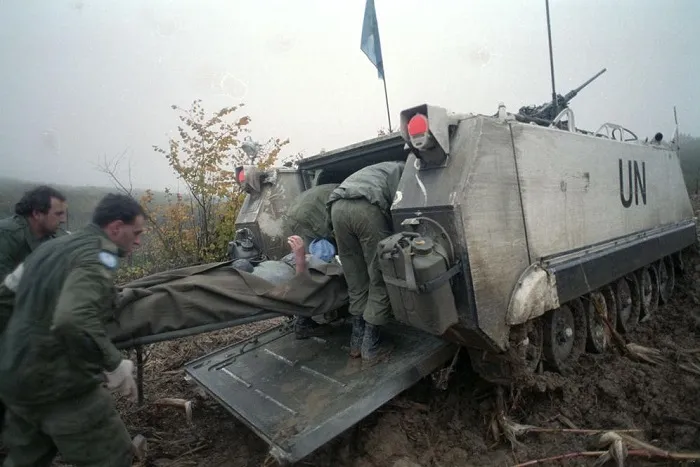
Fighting erupted in Croatia and Bosnia-Herzegovina. In early 1992, the United Nations Protection Force (UNPROFOR) was formed. It protected the civilians within three special “UN Protected Areas” in Croatia and kept other military forces out. By the time the original mandate of UNPROFOR came to an end in 1995, its mission had extended into the wider region. Peacekeepers from dozens of countries, including Canada, served in this effort.
Canada played an important role in UNPROFOR efforts. Canadian soldiers went to the Balkans as a peacekeeping force. But they soon found out that there was often very little “peace” to “keep.” Many CAF members came under fire. This included intense action at the Medak Pocket in Croatia. Canadian troops saw their heaviest fighting since the Korean War during their time there.
In the spring of 1992, fighting escalated in Bosnia-Herzegovina. UNPROFOR moved troops into that area. Their goal was to help the civilians trapped by the fighting and deliver humanitarian aid. A major part of the operation was to open the airport in Sarajevo so supplies could be flown in. In July 1992, as Canadian peacekeepers protected the airport and escorted relief convoys, they often came under fire.
Canada's Major-General Lewis MacKenzie commanded the United Nations (UN) forces in the Sarajevo Sector. He often made international news as he did his best to let the world know the harsh reality there. In the end, our peacekeeping efforts helped keep the vital flow of outside help coming in.
Thousands of Canadian Armed Forces (CAF) members would take part in UNPROFOR efforts. Almost every Canadian infantry battalion and armoured regiment spent time in the Balkans. CAF members played many other important roles during their time with the UNPROFOR. Our service members supplied military engineering, mine clearance, logistical support, electronic warfare and air control capabilities. Canadian warships patrolled the Adriatic Sea to help the UN block arms shipments to the region. Canadian aircraft enforced the UN's no-fly zones and prevented the warring sides from buying weapons.
Through it all, Canadian peacekeepers helped the local people a lot in a variety of ways. For example, they protected humanitarian aid convoys and hospital patients. They also volunteered time and money to donate school supplies and fix damaged buildings.
The Medak Pocket
(15 – 16 September 1993)
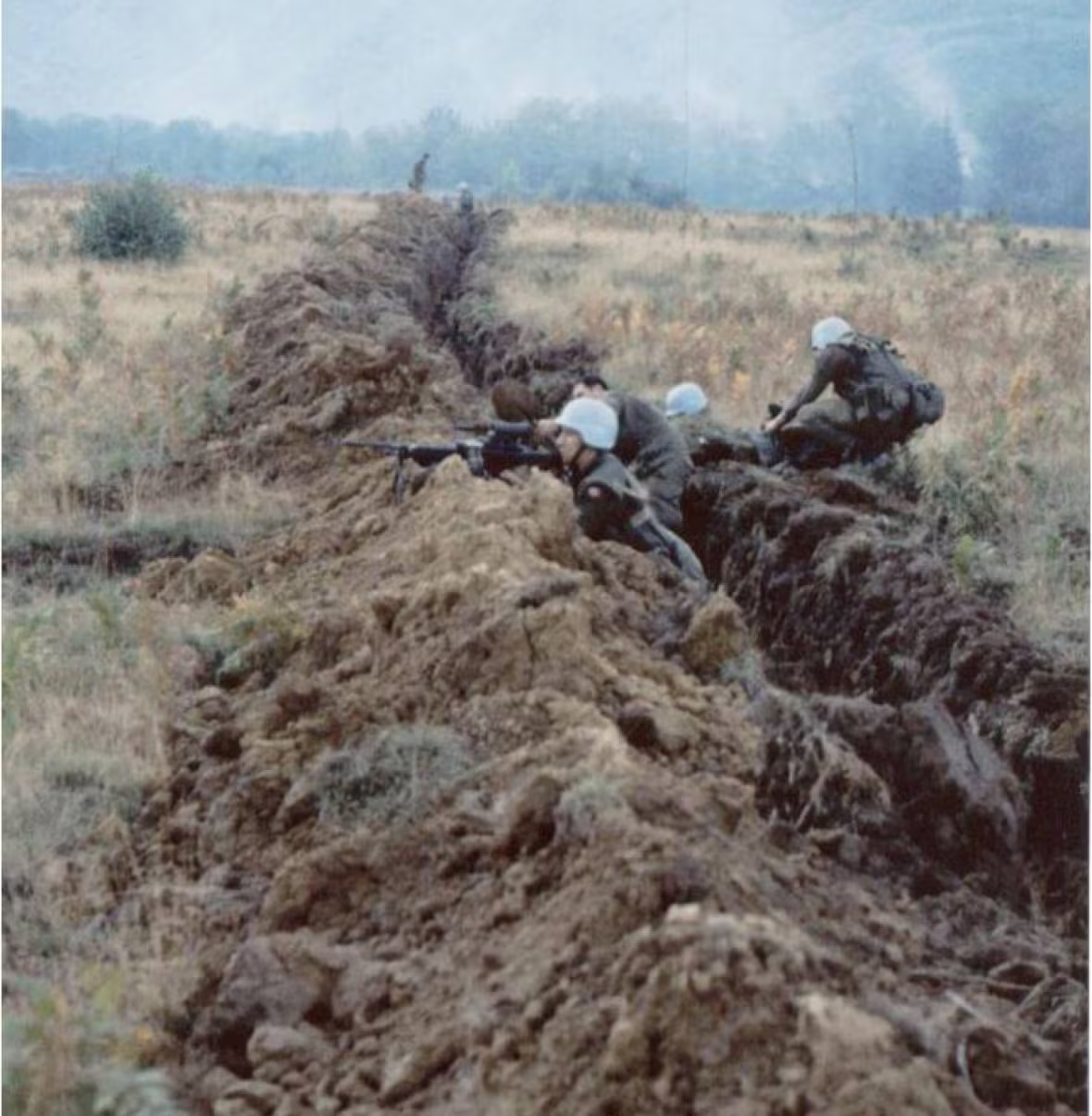
Tasked with protecting civilians in Croatia, Canadian Armed Forces (CAF) came under heavy fire.
Croatian offensive
In September 1993, Croatian and Serbian forces fought in the Lika region of southern Croatia. On September 9, Croatian troops attacked near the town of Medak and pushed the Serbian line back. This created the so-called “Medak Pocket,” Croatian-held territory populated by Serbian people.
Negotiating a ceasefire
Political and public pressure forced the Croatian forces to agree to a ceasefire with the Serbs. The terms of the agreement required both forces to return to their original positions and leave the Medak Pocket on September 15. It fell to UN peace support troops to enforce the fragile agreement.
Canadian soldiers in the middle
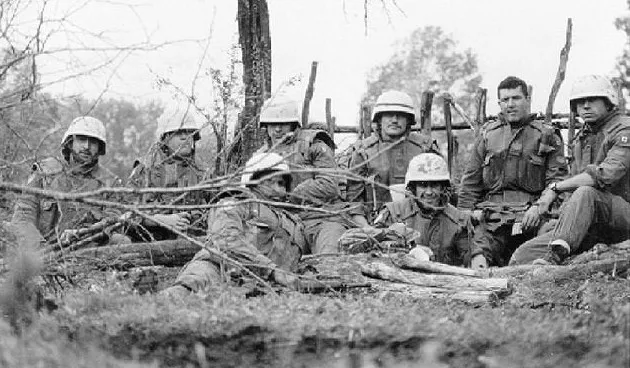
The 2nd Battalion, Princess Patricia's Canadian Light Infantry were the best UN troops available for this mission. Supported by two companies of French soldiers, they were to enter the Medak Pocket and make sure both sides left. They were also to help refugees return to their homes in the area.
On September 15, as the Canadian and French troops advanced, Croatian forces began firing on them. The UN troops dug in and created a defensive line. Croatian artillery, rifle and machine gun fire poured in. The Canadians returned fire to defend themselves from the attack. They drove the Croatian forces back over the next 15 hours. It was the heaviest action that Canadian troops had experienced since the Korean War.
A standoff with the world watching
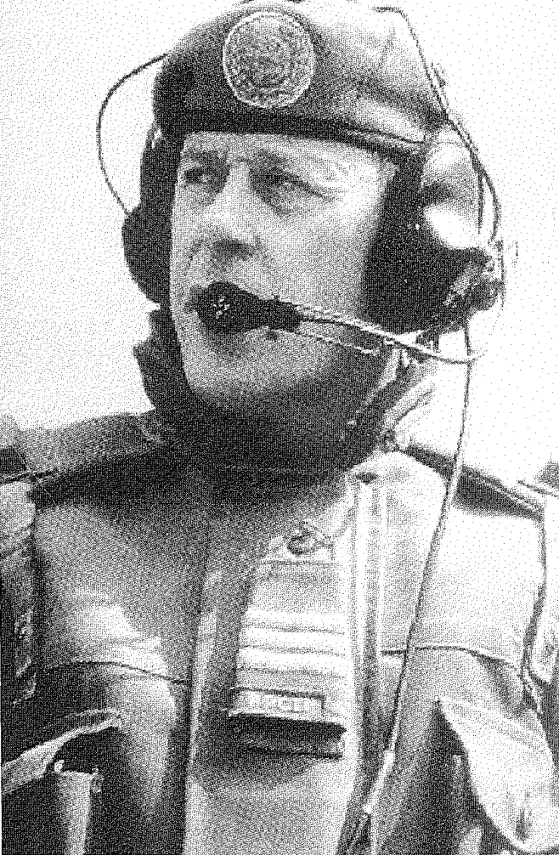
The Canadian commander Lieutenant-Colonel James Calvin negotiated with the Croatian forces. They agreed to withdraw at noon on September 16. But when the UN troops tried to enter the Medak Pocket, they still faced a Croatian roadblock and minefield.
Evidence suggested our troops were being kept out so the Croatians could complete ethnic cleansing there. So Lieutenant-Colonel Calvin held a news conference with international reporters at the scene. He said the Croatian forces were not holding up their end of the ceasefire agreement and hiding their attacks on Serbian civilians. The Croatian forces finally backed down and allowed the UN troops to pass.
The aftermath in the Medak Pocket
The UN forces could finally enter the Medak Pocket. They discovered evidence of horrible violence against the local people. Many Serbian villagers were dead—victims of what looked to be ethnic cleansing by Croatian troops. The Canadians recorded in detail what they found in the villages. Their records were part of later war crimes investigations. Four Canadian soldiers were wounded during the fighting at the Medak Pocket. But the UN forces had persevered. They forced the Croatians to cut short their ethnic cleansing and prevented more civilian deaths.
A special commendation

In 2002, Governor General Adrienne Clarkson recognized Canadians who fought in the Medak Pocket. She awarded the Commander-in-Chief Unit Commendation to the 2nd Battalion, Princess Patricia's Canadian Light Infantry. This award goes to any unit or sub-unit “that has performed an extraordinary deed or activity of a rare high standard in extremely hazardous circumstances.”
NATO efforts in the Balkans
March 1999 – April 2004
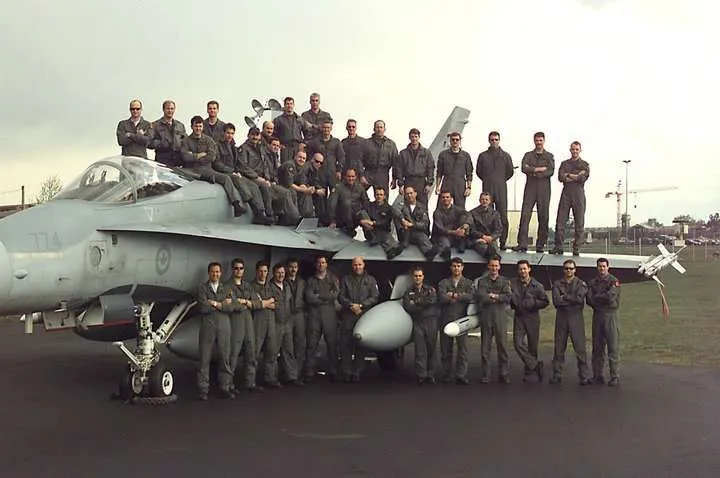
Canadian Armed Forces (CAF) warplanes took part in NATO air strikes in Kosovo. They saw some of their heaviest action since the Korean War.
North Atlantic Treaty Organization takes over
The original mandate for UNPROFOR ended in the spring of 1995. Three different multinational forces took over its roles in the Balkans. Two were in Macedonia and Croatia. A restructured UNPROFOR continued in Bosnia and Herzegovina. By December, the North Atlantic Treaty Organization (NATO) had taken over most of the peace support duties in the region. CAF members continued to serve in the Balkans, but now it would be as part of a new NATO mission.
NATO Implementation Force

The Dayton Peace Accord of December 1995 laid out the terms to end the fighting in Bosnia and Herzegovina. A multinational peace Implementation Force patrolled the ceasefire lines and other borders. It helped keep citizens safe, assist local police forces and monitor elections. The Implementation Force also helped refugees return and rebuild the economy.
More than 1,000 CAF members served with the Implementation Force in many roles. This included a headquarters group, a reconnaissance squadron, a mechanized infantry company, an engineer squadron, and command and support elements.
NATO Stabilization Force

The Stabilization Force was the next phase of NATO peace support efforts in Bosnia-Herzegovina. Formed in December 1996, it saw multinational peace support troops patrol the country. It helped establish lasting peace in the war-torn land. Its goal was to help set up a democratic nation that would sustain the peace process without help from multinational peace support forces. Some 1,200 CAF members would serve with the Stabilization Force.
Unrest in Kosovo
In 1998, the Serbian military and the local Albanians began fighting in Kosovo. Despite attempts by NATO to enforce peace, the violence continued. The Serbian military repeatedly attacked civilian Albanian residents in Kosovo. NATO threatened military action against the Serbians if a lasting ceasefire was not signed. When negotiations failed, NATO forces began an air campaign.
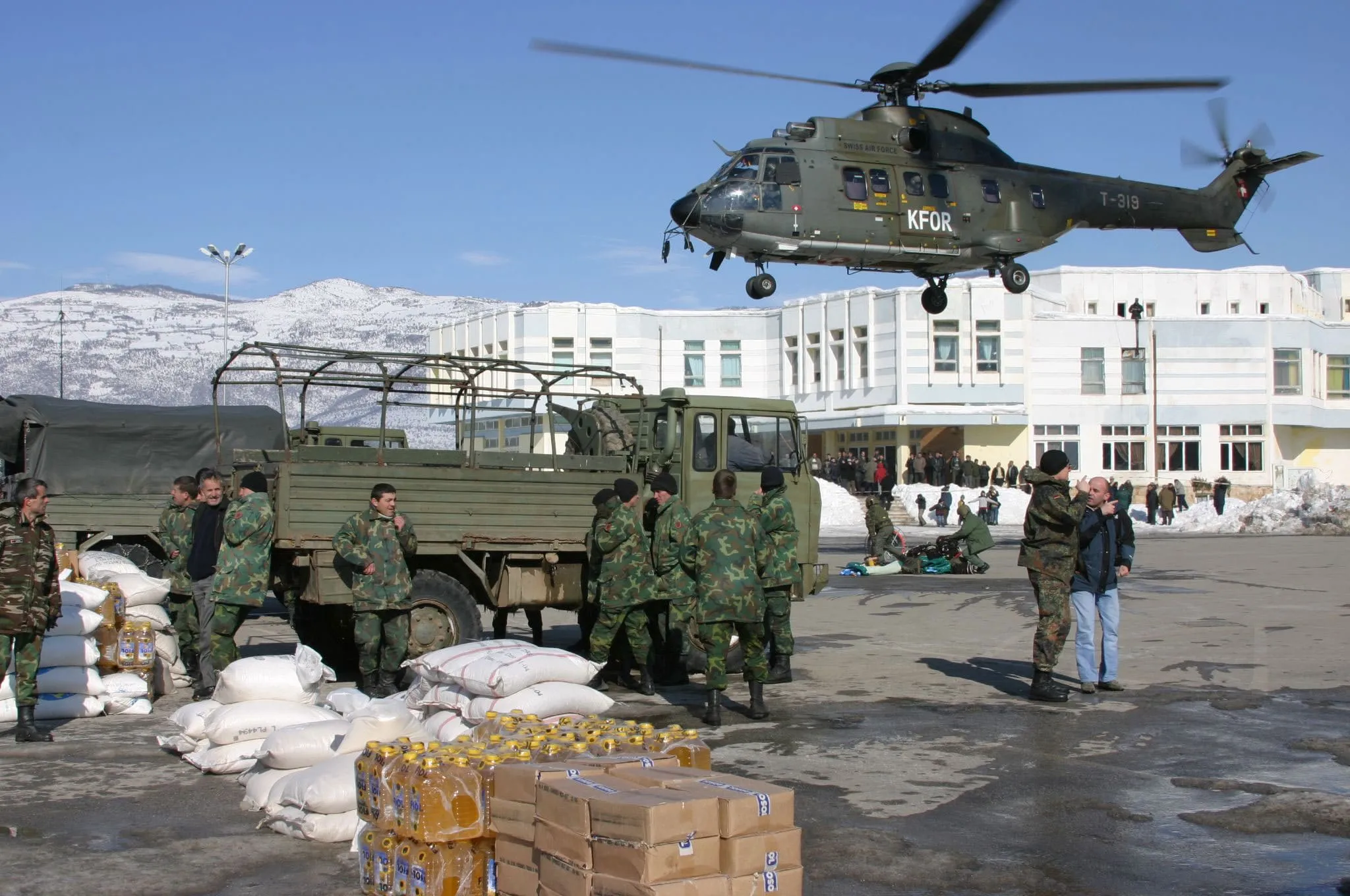
Operation Allied Force

Canadian CF-18 Hornets take off from their base in Italy to strike targets in Kosovo in 1999, depicted in the painting “Balkan Strikers” by Robert Bailey.
Operation Allied Force was the code name given to the NATO bombing campaign in Kosovo. Its goal was to drive the Serbian military out of Kosovo. In March 1999, Canada committed six CF-18 jets—a number that grew to 18 by the end of the mission. Canadian warplanes made up 10% of the missions flown in Kosovo. This was the first time Canadian pilots flew combat missions since the Korean War.
Ceasefire
The NATO bombing campaign did a lot of damage and took a toll on the Serbian forces in Kosovo. With its plans to end the bombing, NATO deployed ground forces to Kosovo and nearby Macedonia. In June, Serbian forces accepted a ceasefire agreement and NATO's Kosovo Force rolled in.
Canada's role in the Kosovo Force
Canada initially dedicated roughly 800 peace support troops to the Kosovo Force and soon added 500. Canadians helped maintain the fragile peace, protected civilians and provided reconnaissance support. The CAF deployed an armoured reconnaissance squadron, a tactical helicopter squadron, a field engineer squadron, an infantry battle group, and command and logistical supports elements.
They led patrols and monitored activities. Our soldiers also carried out many humanitarian aid projects in Kosovo. They rebuilt damaged schools and medical facilities. They installed small bridges and put up playgrounds for local children.
In December 1999, the first Canadians to serve in the Kosovo Force rotated out. By June 2000, most of the Canadian military personnel had left.
On the road to peace
By December 2003, the situation in Bosnia had improved. NATO reduced the size of the Kosovo Force, and the Canadian contingent dropped to about 650 people by April 2004. The European Union Force led the multinational peace support troops in late 2004. As the mission evolved into this new form, the number of CAF members in the country reduced to less than 85.
A Liaison and Observation Team led Canada's role with the European Union Force. These troops kept in close contact with local authorities, police departments, community leaders and army units. They helped develop a peaceful society, collect illegal weapons and prevent smuggling. As a lasting peace took root, the CAF withdrew its last troops from Bosnia and Herzegovina in 2007.
A handful of CAF members are still serving in the Balkans today. The region has recovered since the devastating civil wars that swept through the former country of Yugoslavia in the early 1990s. Almost 40,000 Canadian peacekeepers served there over the years. They played a major role in helping achieve this hard-won security and stability.
Sacrifice

Major Hillary Jaeger, Sergeant Danny Noyes and Corporal Phil Fewer of Second Canadian Battalion Field Surgical Team treat a mortar casualty prior to transport to Camp Visoko Hospital.
Canadians can be proud of our country's reputation around the world as a force for peace, but this comes at a price. About 130 Canadians have died in the course of international peace support operations. In the Balkans, 23 of our service members died and many more were injured.
The wounds of peacekeeping are not always caused by hostile fire, land mines or accidents. Sometimes the scars of service are psychological. Canada's military efforts in the Balkans were particularly difficult for our soldiers. The war crimes and atrocities committed against the civilian population there were horrific. Witnessing such human brutality often has a deep impact on those who see it.
(Veterans Affairs Canada (VAC))
https://www.veterans.gc.ca/en/remembrance/wars-and-conflicts/caf-operations/balkans
